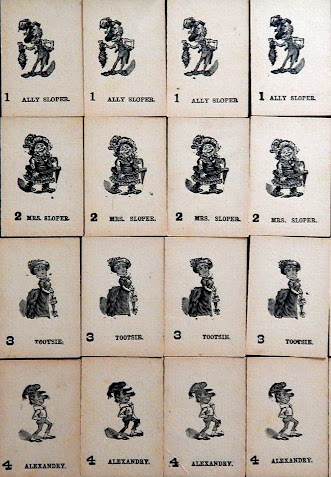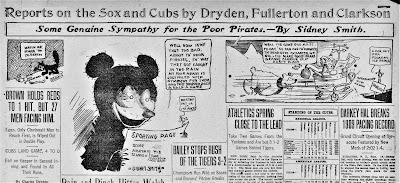THE RARE “SLOPER FAMILY” CARD SET or “IF YA
CAN’T WIN ‘EM…PRINT ‘EM”!
by
Bill Leach
This card back image comes from the rare German children’s book “ALLY SLOPER AND THE PAINT POT”.
As an avid collector of Ally
Sloper art and objects, I had been trying to find a set of the unsanctioned
SLOPER FAMILY playing cards. I had only
seen two sets in all my years of collecting.
The first set was on another collector’s web page and was NOT for
sale…but he was kind enough to send me scans of his set.
This is the complete set of SLOPER FAMILY cards featuring all four ethnic suits. There are 48 cards in the deck. Another set of four cards and two Jokers were added in order to create a contemporary set of cards.
Then years later a set popped
up on EBAY. I placed my bid and won the
set for a reasonable price. I paid for
the purchase and a day later the seller wrote me stating that he had cancelled
my bid, refunded my money and that they were no longer available. Well, we all know what that means….the seller
was offered a better price from another person….so he sold the cards (and his
personal integrity) to another person. By cancelling my bid it took away my
ability to leave a negative feedback. I
guess people without any integrity know how to work the system. Well, I was very disappointed, but what can
you do? You can’t force a person to be
honest even when they are contractually and morally obligated to do the right
thing. So I had to live with the fact
that I had lost out on the set of cards that I had so dearly wanted to add to
my collection.
I looked at the scans the
other collector sent me and wondered if he would be willing to send me better
scans, so I could print them out. He
responded and let me know that he could not scan them again as he had since
matted and framed the set. Then he
followed up by letting me know that he had decided to sell them and they were
at an auction house in the UK. So I
signed up for the auction and waited. I
was a bit concerned, in addition to the auction house fees, there were VAT
taxes and a very high price to pack and send the large framed piece to the US. But I was willing to pay the price and waited
patiently for the day of the auction. There
is an 8 hour difference between the US and the UK, so I waited until the wee
hours of the morning and signed into the live auction being streamed over my
computer. I watched lot after lot go by,
waiting for my chance to bid on the SLOPER FAMILY card set. Finally it was time. I was set to go. The lots were flying through at a rapid pace
and it was my turn to bid. I clicked on
the BID button…nothing happened…clicked and clicked again, until I heard the auctioneer state that the lot had
closed, with me sitting frustrated at my computer, never even getting a single
bid through to the auction house. The
set sold for a fair price…a bit more than I had paid through EBAY, and I was
devastated. I complained to my wife and
told her what had happened. She was sympathetic
but after a few hours of my moaning and complaining she had had enough and told
me to put on my “big boy pants” and get over it. Well, the nerve of some people!!!

The SLOPER FAMILY card set hammered out at 220 pounds even without my bid!
But she was right, I was
wasting time and energy on something that was out of my control….I could no
more change my fate at the auction house, than I could change the lack of moral
compass of the EBAY seller who refunded my legitimate purchase, so he could
sell it to out from under me. What to
do…WHAT TO DO?!!!
I decided if I could not add a
set of these turn of the century cards to my collection I would print up a set
from the scans the first collector sent me.
But the scan quality was poor and the cards were not in the best of
shape. I consulted with a few friends
that were very computer literate in the digital arts. They gave me a lot of advice and I was able
to carefully clean, repair and recolor each card, making them look better than
new. I enhanced the color and pixel by
pixel corrected the misprinted and misaligned areas. I also changed the numbers and suits so the
cards could be used in contemporary gaming.
Each card was carefully repaired. The text was replaced and any misaligned printing was corrected. The background color was replaced and figural colors were enhanced.
But now I had to create some extra cards, as
it was one set of cards shy of a modern deck, and there were no Jokers. I also needed an image for the back of the
cards. I took a wonderful image from a
very rare German book “Ally Sloper and the Paint Pot” and used it for the card
backs. But what could I do about the
other two cards? I had a set of
“TRIPLEM” cards. This game has each
character divided into three parts, and the game is to reconstruct the characters
to win. I took the three cards with Ally
Sloper’s image and scanned them as one.
After carefully cleaning and repairing the cards, I had one solid image
to use for the ACE. I used this same image
on all four suits…or “families”. As for
the Joker, I used another three cards from the TRIPLEM deck…I used Mr. Punch,
from the PUNCH comic newspaper. Now I
realize that Mr. Punch was NOT part of the Sloper Family, but he IS the Joker
and is dressed as such, so I cleaned him up and used him with good
justification. There is a connection of
this character to Sloper. Ally Sloper
was first published in the pages of JUDY, a comic newspaper in 1867. JUDY was the rival paper of the long standing
PUNCH newspaper (referencing the old Punch and Judy puppet show
characters). While they were two
separate entities, they did go hand in hand….like peanut butter and jelly. So using Mr. Punch as the Joker just seemed
like a good fit.

The TRIPLEM card game features each character broken up into three parts. The object is to build complete characters.
The TRIPLEM decks’ ALLY SLOPER and MR. PUNCH before being digitally assembled.
ALLY SLOPER and MR. PUNCH after being reassembled.
The SLOPER FAMILY card set is very ethnic, some might call it racist. But it was a product of the 1890s and was created and sold without permission. There were four suits, but instead of hearts,
diamonds, clubs and spades, the creator used ethnic families: ENGLISH, CHINESE, EGYPTIAN and AFRICAN. Each card represented a person in the Sloper
Family and their personas and names changed with the varied ethnicities. Today’s gaming companies would never be so bold
as to use these various ethnic personalities, but in the 1890s, it must have
been fair game.
The ENGLISH suit of THE SLOPER FAMILY CARD GAME
The CHINESE suit of THE SLOPER FAMILY CARD GAME
The EGYPTIAN suit of THE SLOPER FAMILY CARD GAME
The AFRICAN suit of THE SLOPER FAMILY CARD GAME
It took me over an hour to
repair each card, but in the end I had a nice digital card set. Initially I was going to print up one set at
the local print shop on one of their nice printers/copiers. But they could not run card stock through the
machine. So I decided to have them professionally
printed by an online gaming company. I
was shocked when I found out how much it would cost for one set of cards. In the end I decided to print two dozen sets,
which brought the price down quite a bit.
So I got the set for my collection and a case of card sets to sell to my
collector friends. Then I realized, I
don’t have ANY collector friends that collect Ally Sloper. This situation is a double-edged sword; on
one hand, I don’t have any competition when collecting Sloper material, at
least not from US collectors. But I also
don’t have any friends that I can brag to about my Sloper treasures, nor do I
have any friends with Sloper material that I can buy, sell or trade with. They say no man is an island, but I am a man
all alone on the Sloper Sandbar.

This partial set of THE SLOPER FAMILY CARDS were printed much smaller. The deck featured four each of only the ENGLISH suit printed with black ink. The print quality was very poor.
There was also another
unsanctioned set of THE SLOPER FAMILY GAME.
The set used the same imagery but was printed in black and white and
eliminated the ethnic cards by using four each of the “ENGLISH” suits. This set was smaller and very poorly
printed.
How did I become such an obsessed
SLOPERIAN COLLECTOR? It all goes back to
the early eighties. A crazy collector
friend of mine named Ronald Graham called me up and said, “Bill, you have to
buy this book….I don’t have the money, but you need to get this book. It is a really rare bound volume of Ally
Sloper’s Half Holiday”. He gave me a
phone number and I called it. The book
was about $65.00 and contained a years’ worth of weekly comic newspapers from
1898 featuring the title character ALLY SLOPER on the cover and
throughout. What Ronald Graham did not
know, and what caused me to take his advice was that my Mother’s maiden name
was Sloper and my Sloper lineage goes all the way back to the 1500’s in England,
Scotland and Ireland. So when the book
arrived, I shared it with my Mother and we both got a kick out of it. So much that I decided to try and collect
MORE Sloper art and objects. This is a
bit harder to do than I thought. Most
Sloper items I have found are not in the US and dealing with auction houses and
postage can be an expensive proposition.
But over the last forty years, and a big thanks to the internet, I have
been able to amass the largest collection of Sloper original art and
merchandise in the world. I challenge
anyone to prove me wrong.

The SLOPER FAMILY burial plot in Northern California now includes Bill Leach's parents, James H. Leach and Shirley Mae Leach formerly Shirley Mae Sloper.
My parents have since passed
and are buried in the Sloper Family plot in Northern California. I will be there someday….but not today. Today I share my newly printed SLOPER FAMILY
CARD SET with all of you. Cheers!
Bill Leach poses with his newly printed SLOPER
FAMILY cards in front of an original 1899 illustration from ALLY SLOPER'S CHRISTMAS HOLIDAY.
I had to print 24 sets to make
them affordable. If anyone would like to
obtain a set of these cards….please contact me, Bill Leach at: ComicArt4u@comcast.net I only have a small number of these sets left
and doubt I will have any more printed.
I am asking $25.00 plus shipping per deck.














































